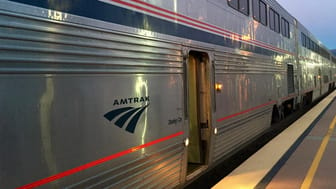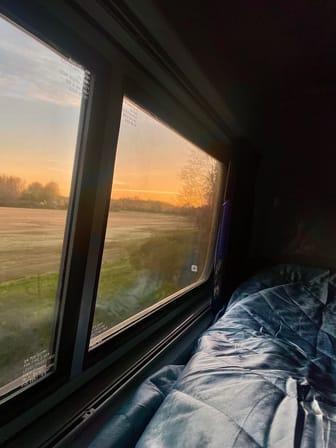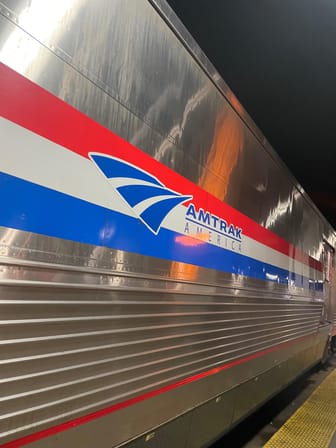Amtrak LD Trains: On-Board Experience
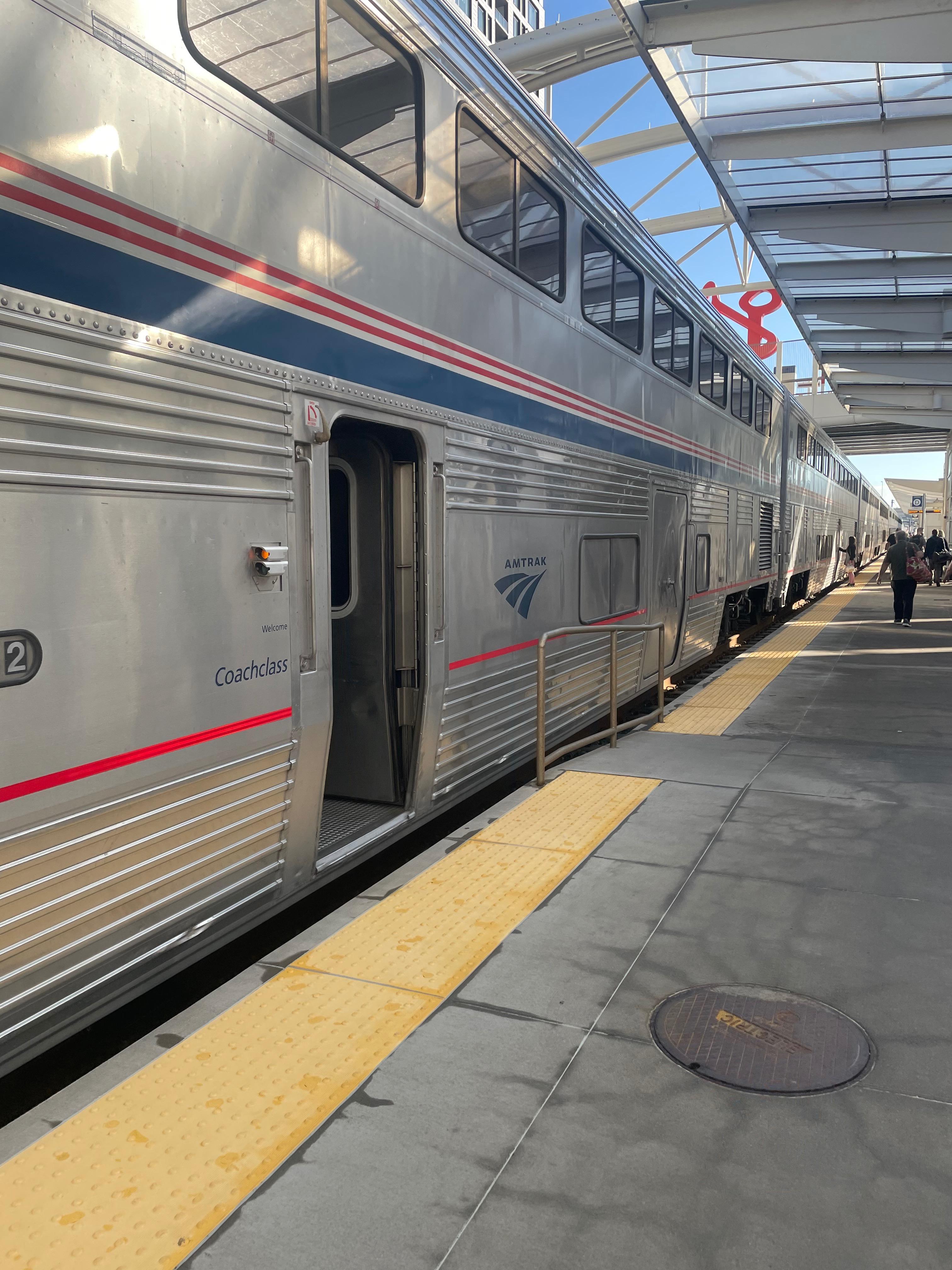
Hello and thanks for being here! If this is the first time you have been to this page or are completely unfamiliar with Amtrak long-distance routes, I invite you to please take a look at the following three-part guide about all 15 of the LD routes across the country. It might give you an idea of which one you want to ride first!
ACCOMMODATIONS & TRAIN LAYOUT
- Amtrak operates with two different sets of equipment on the long-distance trains depending on destination: Viewliner or Superliner cars.
VIEWLINER EQUIPMENT
- The most simplified explanation is Viewliner cars operate on any routes that originate or terminate in New York City. This is due to tunnel restrictions in Manhattan as well as along the Northeast Corridor. Routes using Viewliner equipment are as follows:
~ Cardinal
~ Crescent
~ Lake Shore Limited
~ Silver Meteor
~ Silver Star
- Viewliners are single-level equipment and are sleeper and dining cars only (and baggage), which means they are paired with Amtrak’s standard Amfleet coach cars seen predominantly along the Northeast Corridor.
COACH
- Amfleet coaches have approximately 60 seats with big picture windows and are set in a 2-by-2 configuration. The seats recline to a nearly 45-degree angle when fully set and there is more than enough space between the seats for a 6’ tall individual to completely stretch out. Bathrooms are located at the end of every car.

Amfleet Coach Interior (Amtrak)
SLEEPER
- Sleeper cars are typically at the front or rear of the train and separated from the coaches by the cafe, diner and/or lounge. Coach passengers are not allowed access to the sleepers.
ROOMETTES
- The smallest Amtrak sleeper accommodation (6’6”-6'8” L by 3’6”W)
- Each have two single berths, like a bunk bed
- The two seats (during the day) fold down into the lower berth at night. Meanwhile, the upper berth slides down on a rail from above
- There is a very large storage space across from the upper berth that can fit multiple carry-ons.
- Perhaps the biggest benefit of the Viewliner cars is each roomette has a large window parallel to each bed.
BEDROOMS
- Double the size of the roomettes (7’1”-7’6” L by 6’6”-6’8” W)
- Feature a double-sized lower bunk, which is a sofa during the day
- Single berth above like a roomette. There is also a chair, which sits opposite of the sofa during the day.
- Toilet and shower combo in the room.
- Each car has an accessible bedroom, which is similar, but larger than the regular bedroom and includes accessible features.

Viewliner Sleeper Exterior (Wikipedia)
Viewliner I Interior (Business Insider). Toilet is beneath the backpack in the picture, sink is folded in above.
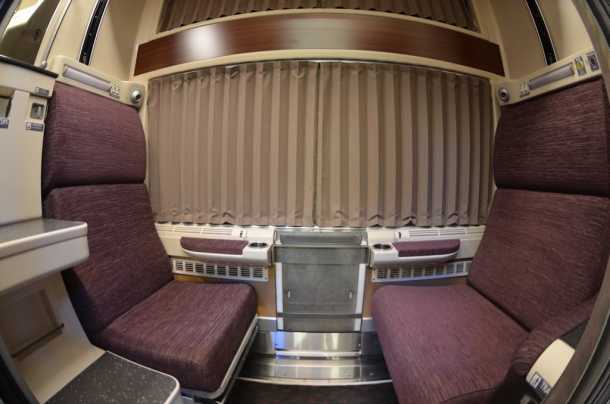
Viewliner II Interior in day mode (trainsandtravel.com). Seats slide into a lower berth and upper berth drops down from above. Toilet has been removed (replaced by a step), but the sink still drops down.
DINING/CAFE CAR
- The Viewliner dining car is currently reserved for sleeping car passengers only.
- Currently, the only Viewliner routes to offer traditional chef-prepared meals are the New York to Miami, Silver Star and Silver Meteor, routes (see Superliner section).
- All other routes using Viewliner equipment — Cardinal, Lake Shore Limited and the Capitol Limited — offer a ‘flexible’ lunch/dinner option
- Involves an airplane style entree with a side salad and a dinner roll as well as a desert choice (usually a cookie/brownie) and a soft drink. Dinner comes with one complimentary alcoholic beverage.
- For breakfast, there are typically a couple of limited options on top of a continental breakfast choice.
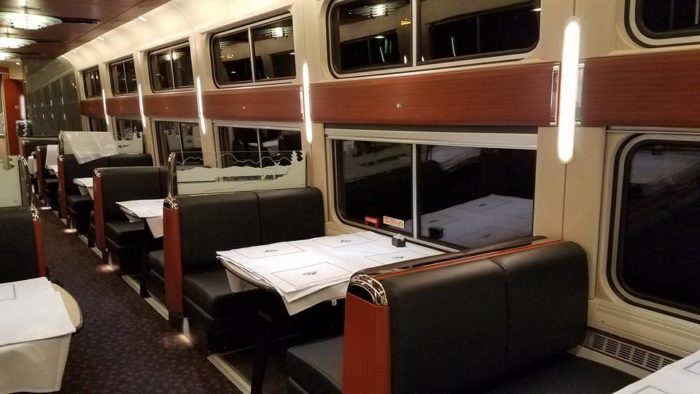
- All other passengers are welcome to buy food from the on-board cafe car, which like the coach cars are of the Amfleet variety.
- The cafe car has a small service area with several tables; at times, depending on if the car is added to the consist, there are cafe cars that also have a small business class seating area that is separated by a privacy curtain.
SUPERLINER EQUIPMENT
- Any long-distance trains not operating through New York City run with Superliner Equipment. These are the bi-level train cars and are on the following routes:
~ Auto Train
~ California Zephyr
~ Capitol Limited
~ City of New Orleans
~ Coast Starlight
~ Empire Builder
~ Southwest Chief
~ Sunset Limited
~ Texas Eagle
COACH
- Coach cars are similar to the Amfleets above, but are on the upper level with the bathrooms downstairs.
- Approximately 60 seats in a 2-by-2 configuration with power outlets at each.
- Very generous pitch with about 39-40 inches to the seat in front of you (for comparison, most airplanes have about 29-30 inches of space.)
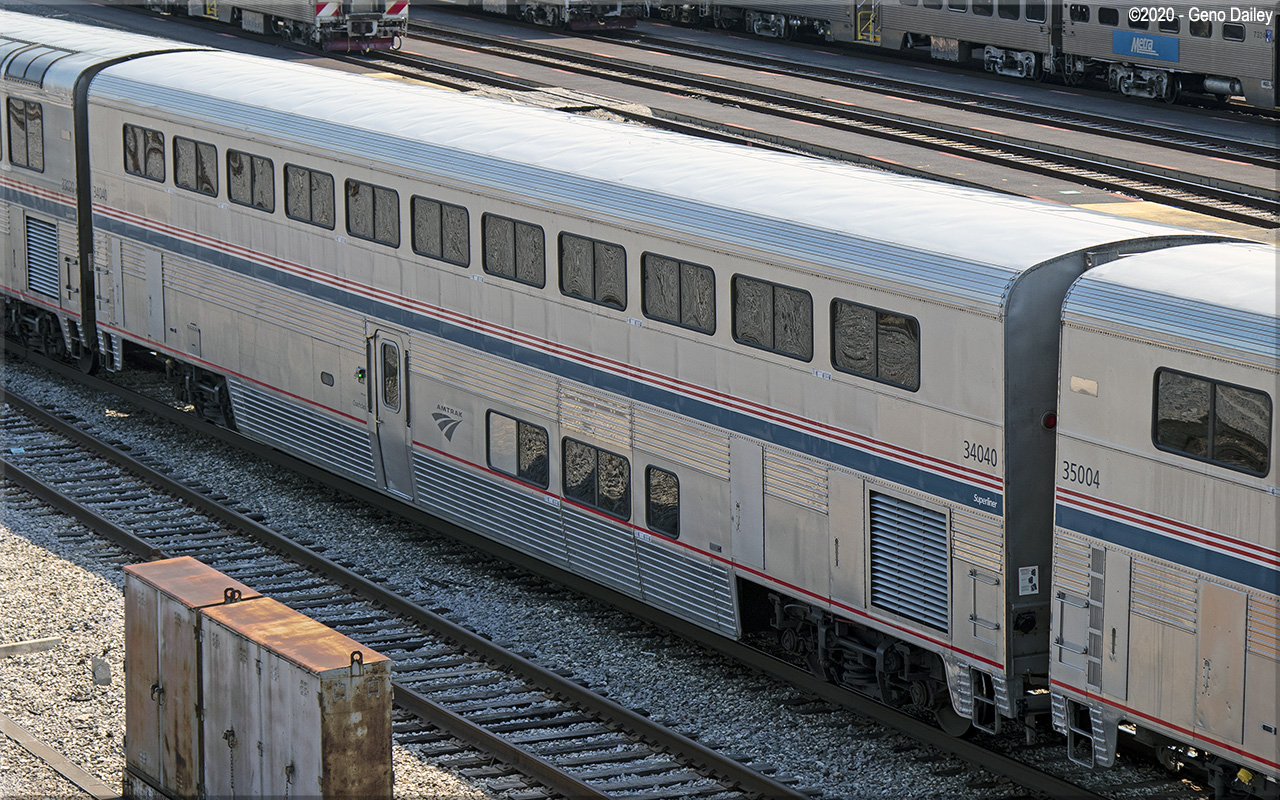
Superliner coach w/ lower level (trainweb.org)
- Select coach cars have sections with lower level seating.
- Most trains run with at least one (to meet ADA requirements) and they have 12 seats in the same set-up. Passengers MUST have a lower level specific ticket to sit downstairs and they sell out quickly, so book in advance.

Lower Level Superliner coach seating (railwaypro.com)
SLEEPERS
- Like the coach cars, the sleepers are also bi-level with accommodations on both levels.
- Sleeper cars are typically at the front or rear of the train and separated from the coaches by the cafe, diner and/or lounge. Coach passengers are NOT allowed access to the sleepers.
ROOMETTE
- The smallest Amtrak sleeper accommodation (6’6”-6'8” L by 3’6”W)
- Each have two single berths, like a bunk bed
- The two seats (during the day) fold down into the lower berth at night. Meanwhile, the upper berth fold down on a hinge from above
- Unlike the Viewliners, there is only one large window next to the seats and the lower berth
- There are 10 on the upper level and four more downstairs
BEDROOM
- Double the size of the roomettes (7’1”-7’6” L by 6’6”-6’8” W)
- Feature a double-sized lower bunk, which is a sofa during the day
- Single berth above like a roomette. There is also a chair, which sits opposite of the sofa during the day.
- Toilet and shower combo in the room.
- Five on the upper level (no standard bedrooms on the lower level)
*Select bedrooms have the ability to be joined (like a hotel) to, in essence, become a two-bedroom suite.*
FAMILY BEDROOM
- Single largest accommodation available on a Superliner (9’5”L by 5’2”W)
- One in each car, on the lower level
- Sleeps four (two adults and two children)
ACCESSIBLE BEDROOM
- Larger version of a roomette (double the size, but similar setup) with accessible features (7’1”-9’5” L by 6’8”-6’9” W)
- Sleeps two adults in two single berths
- Full toilet/sink combo
- One in each car, on the lower level
RESTROOMS

Amtrak Superliner Roomette (Amtrak Vacations)

Amtrak Superliner Bedroom (Amtrak Vacations)

Amtrak Family Bedroom (groundedlifetravel.com)
DINING CAR & CAFE/LOUNGES
- The Superliner dining car offers a full-service breakfast and lunch as well as a traditional chef-prepared three-course dinner service.
- Sleeping car passengers have priority and meals are included in their fares.
- Typically coach passengers are offered the opportunity to purchase a meal if they so choose.
- Traditional dining is offered on the Auto Train, California Zephyr, Coast Starlight, Empire Builder, Southwest Chief and the Sunset Limited routes.
-Flexible Dining (as detailed in the Viewliner section) is available on the other Superliner routes. This includes the City of New Orleans as well as the Texas Eagle (Chicago-San Antonio only; The Sunset Limited has a dining car, so traditional dining is offered after the trains are combined in San Antonio all the way to Los Angeles and vice-a-versa to New Orleans.)
STAFF
- Depending on the length of the route, there are typically 13-15 staff members on the train at any one time
- 1-2 Conductors/Assistant Conductors
- 1-2 Engineers
- 1-2 Coach Attendants
- 1-3 Sleeper Attendants (typically one per sleeper car)
- Cafe Attendant
- Chef
- Food Specialist
- Dining Car Lead Service Attendant
- 1-2 Dining Car Attendant(s)
CONDUCTOR/ENGINEER HOURS
- The conductor/assistant conductor are in charge of the train and alongside the engineers, work to make sure the train gets to its destination safely
- They typically work 8-10 hours before changing with a new crew. The most they are allowed to work in a single shift (per federal law) is 12 hours.
- This is because both are considered safety sensitive positions, which means the conductors are awake for the entirety of their shift, even if it is 3 a.m. They are also rule- and location-qualified on the territory they work and therefore cannot extend past those locations.
- For example, Grand Junction, CO is a crew change point for the Salt Lake City and Denver crews. Salt Lake City works from Utah’s capital to Grand Junction, while Denver works from Grand Junction to the Mile High City. The SLC crew cannot work east of Grand Junction (without host railroad help) because they are not qualified on the route.
ON-BOARD STAFF HOURS
- On-board staff (listed above except for the conductors and engineers) ride the train from its originating point to the end and then back
- Again, depending on the route, these staff members could be gone from home for at least six days
- For example, in the case of the California Zephyr, the train is crewed out of Chicago and the staff goes all the way to Emeryville before returning back to Chicago on the next day’s train
- Attendants are typically available consistently from 6:30 a.m. to 10 p.m. aside from during their meal breaks.
- Dining car staff are available during scheduled meal times, which are announced.
- Cafe car is typically open consistently from 6-6:30 a.m. to 11 p.m. aside for meal/restroom breaks
- The train is a 24-hour operation and the staff are often running on fumes. If you feel a staff member is not being the most friendly, please be understanding of the situation, as patient and kind as possible. That being said, feel free to report the situation to a conductor if it gets out of control.
TIPPING
- Tipping is always appreciated, but never expected. If you find the service meets or exceeds your expectations, please tip accordingly. On the other hand, if you feel the service was poor, don’t be afraid to show it by tipping less or not at all.
- Ultimately, tip as much as you feel comfortable, but some recommendations are below:
- Sleeper Attendant: $5-$10 per day
- Diner: $2-$5 per person per meal
- I’ve seen questions about tipping coach attendants and while I can say it doesn’t happen often, in my experience, it is very much appreciated. Again, if you feel the service has been higher than what was expected, feel free to throw a couple of dollars their way
WIFI
- There is NO WIFI on the majority of Amtrak trains, but especially on the long-distance routes. You may find some connection on regional trains.
- Most routes spend a large majority of the trip “off the grid,” passing through very rural areas or natural features (canyons, mountains, forests) where there is no satellite coverage and thus no cell signal or wifi
- While you may have stretches where you can get cell signal, there will also be places where you may lose signal for several hours
ENTERTAINMENT
- For the above reasons, it is highly recommended to download any movies, tv shows or books you may want for the entirety of your trip
- Go old fashion! Bring a hard copy book or perhaps some puzzles like crosswords or word searches
- Cards are always a great way to pass the time and if you can find a table in the observation car, can be a great way to make new friends
- FYI, you cannot openly gamble with money on the train. That being said, I have seen people play with chips or other tokens and not have a problem. Take that as you will.
- BRING HEADPHONES/AIRPODS or some other kind of device for watching/listening. During day time, all volumes must be kept low enough to avoid disturbing other passengers and at night, it is absolute silence. So if you want to watch/listen comfortably, bring headphones.
- Chances are, from my experience, you will end up looking out the window getting lost in the scenery, talking to a stranger/new friend or snoozing for a majority of the trip. I usually bring a couple of books and movies and I’ll be lucky if I read half of one.
SLEEPING
- Sleeping car passengers receive the full hotel treatment in their respective accommodations: blankets, sheets, pillows, towels, etc.
- Coach passengers are very much on their own and blankets/pillows are not available for purchase from the sleeper cars.
- Amtrak has 'comfort kits' to purchase online (throw blanket, inflatable pillow, eye shade, ear plugs). I have seen them on board trains in the past, but it is not guaranteed. Therefore, it is recommended to come prepared.
- It can get cool overnight on the trains and with the aging Superliner equipment, the HVAC system can be finicky. Even if you sleep warm, I recommend carrying a blanket.
- Earplugs and eye shades are plus if you are a light sleeper, especially since you may be assigned a seat near the end doors or the stairwell lights. If you prefer white noise, you may find the sounds of the train and the horn help you drift off.
- Keep your shoes available. No one really expects you to sleep with them on all night (unless your feet smell!), but when you get up from your seat, you must have them on. Attendants and conductors will send you back to your seat if you don’t have them on.
- Coach seats come in pairs and if you are traveling alone, you DO NOT get both seats. Sometimes it works out that way, but if the seat is needed for another passenger, you will be woken up to make room. I have had it happen to me.
DINING CAR
- Amtrak Dining Cars are community seating, which means if you are traveling in a group with less than four, you will be joined by other people at your table.
- It isn’t negotiable and most dining car staff won’t entertain the question.
- If this is a problem, you can try to ask your attendant about getting your meals in your room (although this is typically reserved for those that physically can’t get to the dining car).
- Amtrak policy states the dining car is only open during meal times. It is not a place to gather or watch the scenery.
- Typically during the overnight hours, you can find a conductor in the dining car if you have any questions or need assistance.
- Meal times are typically as follows...
Breakfast: 6:30 am - 9:30 am
Lunch: 11:30 am - 2:30 pm
Dinner: 5:00 pm - 9:00 pm
…however, each crew does things a little differently and if the train is delayed, changes may be made to the schedule. It is always best to listen to the announcements.
LOUNGE/CAFE CAR
DAY
- Seating on the upper level of the Sightseer Lounge is first come, first served.
- It sits approx. 55-60 people and unless they are actively being used, all seats (even at the tables) are expected to be available. This means no holding seats, etc. and I’ve seen some crews collect/confiscate items that were being used to reserve a seat.
- The seats downstairs are reserved for those who purchased something from the cafe and typically for 30 minutes max.
- If all seats upstairs are taken consistently, the crews will typically ask for people to rotate so others get a chance. If that doesn’t work, I have seen some crews institute a reservation system or others empty out the car completely and force everyone back to their seats/room before reopening.
- Unfortunately, due to equipment shortages, Amtrak only provides one Sightseer Lounge per train (sometimes none), so crews have their hands tied as far as solutions to help everyone. Please be patient and understanding.

Sightseer Lounge Seats (RailwayPro)

Sightseer Lounge Tables (Amtrak)
OVERNIGHT
- Lounge cars are typically open all hours of the day and night. In the case of the Sightseer Lounge, only the upstairs is open overnight
- It is a place for passengers to socialize, listen to, watch or otherwise make noise (at a reasonable level) during the overnight hours
- Passengers are not allowed to set up their bedroom in the lounge car
- That being said, if a passenger is just sleeping on a couple of seats with a blanket, staff usually don’t bother you during overnight hours (daytime is different)
CAFE
- The lower level of the Sightseer Lounge car is open when the cafe is open, which is typically between 6:30 a.m. and 11 p.m. except for meal breaks.
LAST BUT NOT LEAST...
- Please be kind, respectful, courteous and have fun on-board!
- Unfortunately, especially in the case of the long-distance trains, there can be delays. Amtrak rents the tracks from the freight railroads and therefore are often at mercy of them. A very large majority of the delays encountered in route are not the fault of the staff on the train.
- It is also recommended not to schedule a close connection (less than three hours) if you are coming off of a long-distance train. The last thing you want is to miss your train and then be stranded. Amtrak will typically help if it is a direct connection from one train to another and your train was more than three hours late. If it is less than three hours, you may be on your own.
Questions? Inquiries? Suggestions? Errors? Reach me - Mitchell - at orientbayadventures@gmail.com.
If there are any topics or questions that I did not cover, please reach out to me. I would love to do a specific Q&A post about these things as I am not always able to remember everything from past travels! Thanks!!
The home for unique & authentic travel
